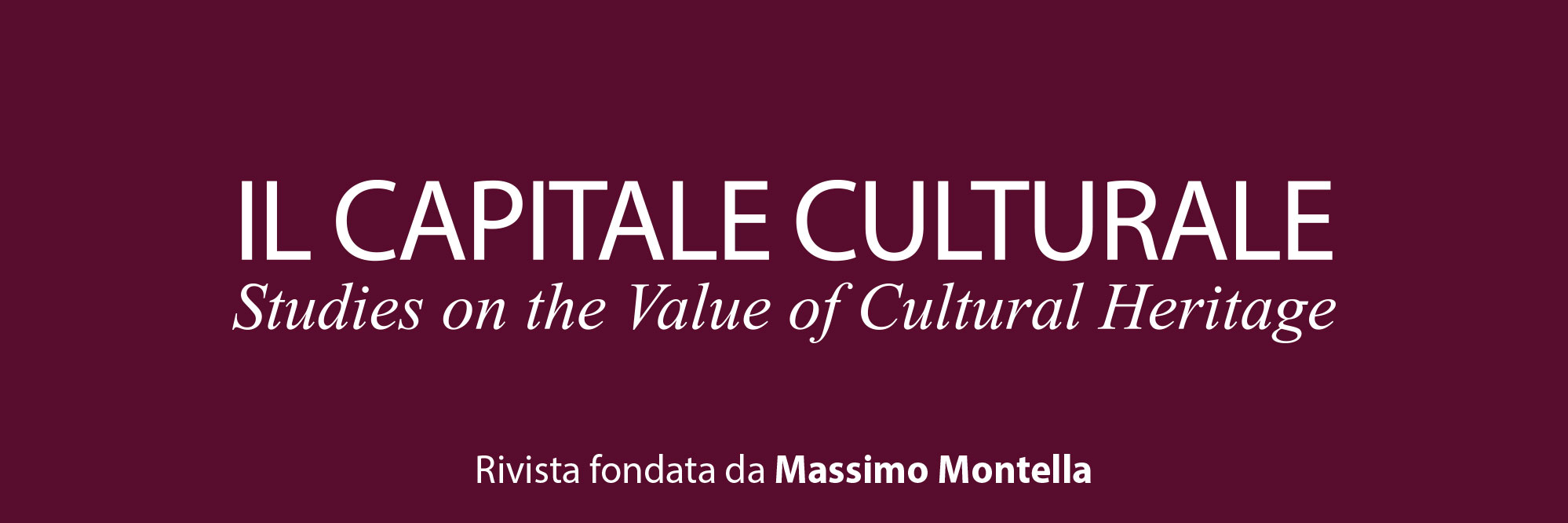La ricerca partecipata nell’archeologia del futuro / Participatory research in the archaeology of the future
Downloads
Pubblicato
Fascicolo
Sezione
Licenza
Tutti i materiali pubblicati sono coperti da copyright, mantenuto dall'Università di Macerata che ne supporta finanziariamente e tecnicamente la pubblicazione.
La licenza adottata è la Creative Commons - Attribuzione/Condividi allo stesso modo. Ovvero, gli autori che pubblicano su questa rivista accettano le seguenti condizioni:
- Gli autori mantengono i diritti sulla loro opera e cedono alla rivista il diritto di prima pubblicazione dell'opera, contemporaneamente licenziata sotto una Licenza Creative Commons - Attribuzione che permette ad altri di condividere l'opera indicando la paternità intellettuale e la prima pubblicazione su questa rivista.
- Gli autori possono aderire ad altri accordi di licenza non esclusiva per la distribuzione della versione dell'opera pubblicata (es. depositarla in un archivio istituzionale o pubblicarla in una monografia), a patto di indicare che la prima pubblicazione è avvenuta su questa rivista.
- Gli autori possono diffondere la loro opera online (es. in repository istituzionali o nel loro sito web) prima e durante il processo di submission, poiché può portare a scambi produttivi e aumentare le citazioni dell'opera pubblicata.
DOI:
https://doi.org/10.13138/2039-2362/2202Abstract
In questo contributo si parlerà del modello o metodo di ricerca partecipata in archeologia, delineandone le caratteristiche principali, le prassi e le problematiche, in rapporto ai progetti che da alcuni anni il gruppo di archeologia medievale dell’Università di Padova porta avanti in varie regioni dell’Italia. La partecipazione delle comunità locali nell’individuazione, conoscenza, tutela e valorizzazione del patrimonio è fondamentale, dal momento che i professionisti dei beni culturali non possono farsi carico di un patrimonio immenso e a rischio di dispersione, che nella maggior parte dei casi scompare prima di essere conosciuto o solo censito. Il coinvolgimento attivo delle comunità nei progetti di ricerca va considerato inoltre non solo come un buon metodo per favorire la tutela, ma anche come un’opportunità di sviluppo economico, sociale e culturale. Infine ci sono anche enormi benefici per gli studenti che partecipano a queste attività, per lo più legati all’apprendimento di conoscenze e competenze, raramente inserite negli odierni programmi accademici.
In this paper the participatory research methods or models in archaeology will be described, outlining the main characteristics, practices and problems, in relation to the projects that for several years the medieval archaeology group of the University of Padua has been carrying out in various regions of Northern Italy. The participation of local communities in the identification, knowledge, protection and management of cultural heritage is fundamental, since professionals of cultural heritage cannot protect an immense and dispersed heritage, which in most cases disappears before being registered. The active involvement of communities in heritage projects should be considered not only as a good method to promote protection, but also as an opportunity for economic, social and cultural development. Finally, there are also enormous benefits for students who participate in these activities, mostly related to the learning of knowledge and skills, rarely included in today's academic programs.
Riferimenti bibliografici
Band L. (2019), CITiZAN 2015-2018 and 2019-2021, a community archaeology project past and future: successes, challenges, potential solutions, «European Journal of Post-Classical Archaeologies», n. 9, pp. 399-409.
Benetti F., Santacroce C.P. (2019), In the public interest? Archaeological research, permits and public participation in Italy, «European Journal of Post-Classical Archaeologies», n. 9, pp. 169-198.
Bonnici U.M. (2009), The human right to cultural heritage – The Faro Convention's contribution to the recognition and safeguarding of this human right, in Heritage and Beyond, edited by D. Therond, A. Trigona, Strasburg: Council of Europe, pp. 53-58.
Brogiolo G.P. (2007), Dall’Archeologia dell’architettura all’Archeologia della complessità, «Pyrenae», 38, n. 1, pp. 7-38.
Brogiolo G.P. (2015), Some principles and methods for a stratigraphic study of the historic landscapes, in Detecting and Understanding Historic Landscapes, edited by A. Chavarría Arnau, A. Reynolds, Mantova: SAP Società Archeologica, pp. 359-385.
Brogiolo G.P. (2018a), Un’archeologia per le comunità locali, in Monterosso: la riscoperta dell’antico, a cura di P.M. de Marchi, D. Francescano, Mantova: SAP Società Archeologica, pp. 87-94.
Brogiolo G.P. (2018b), Per un’archeologia delle comunità rurali nei tempi lunghi. Pagi e vici tra romanizzazione e Alto Medioevo nelle regioni prealpine, in VIII Congresso Nazionale di Archeologia Medievale (Matera 12-15 settembre 2018), a cura di F. Sogliani, B. Gargiulo, E. Annunziata, V. Vitale, Firenze: All’Insegna del Giglio, vol. 1, pp. 26-30.
Brogiolo G.P., Chavarría Arnau A. (2019), Archaeology for local communities in Northern Italy: experiences of participatory research in an adverse legal framework, «European Journal of Post-Classical Archaeologies», n. 9, pp. 101-122.
Castillo Mena A. (2015), Mapping Stakeholders in archaeological heritage management, in Fernweh. Crossing Borders and Connecting People in Archaeological Heritage Management, edited by M.H. van den Dries, S.J. van der Linde, A. Strecker, Leiden: Sidestone Press, pp. 64-67.
Castillo Mena A. (2019), Participative processes in cultural heritage management. Methodology and critical results based on experiences within the Spanish World Heritage context, «European Journal of Post-Classical Archaeologies», n. 9, pp. 61-76.
Chavarría A. (2018), Ricerca partecipata in archeologia: l’esperienza delle summer schools dell’Oltresarca trentino, in La memoria culturale dell’Oltresarca trentino. Paesaggi, persone e storie di pietre, a cura di A. Chavarría Arnau, M.-A. Causarano, Mantova: SAP Società Archeologica, pp. 9-22.
Crooke E. (2010), The politics of community heritage: motivations, authority and control, «International Journal of Heritage Studies», 16, nn. 1-2, pp. 16-29.
Faulkner N. (2000), Archaeology from below, «Public Archaeology», n. 1, pp. 21-33.
Harwood R. (2012), Historic Environment Law: Planning, Listed Buildings, Monuments, Conservation Areas and Objects, Builth Wells: Institute of Art and Law.
Henson D. (2011), Does archaeology matter?, in Community Archaeology. Themes, Methods and Practices, edited by G. Moshenska, S. Dhanjal, Oxford: Oxbow Books, pp. 120-127.
Gould P. (2018), Empowering Communities through Archaeology and Heritage. The role of Local Governance in Economic Development, London: Bloomsbury.
Karl R. (2019), Authorities and subjects? The legal framework for public participation in Austrian archaeology, «European Journal of Post-Classical Archaeologies», n. 9, pp. 219-256.
Lewis C. (2014), The power of pits: archaeology, outreach and research in living landscapes, in Living in the landscape: essays in honour of Graeme Barker, edited by K. Boyle, R.J. Rabett, C.O. Hunt, Cambridge: McDonald Institute for Archaeological Research, pp. 321-338.
Lewis C. (2015), Knowledge, impact and legacy in community heritage research projects, AHRC Connected Communities Heritage Network Symposium Proceedings (Sheffield, 16 January 2015), Sheffield: Connected Communities Heritage Network, pp. 10-22.
Little B.J., Shackel P.A., eds. (2007), Archaeology as a Tool of Civic Engagement, Lanham MD-New York-Toronto-Plymouth: Altamira press.
MacAnany P.A. (2014), Transforming the terms of engagement between archaeologies and communities: a view from the Maya region, in Transforming Archaeology: Activist Practices and Prospects, edited by S. Atalay, L.R. Clauss, R.H. McGuire, J. Welsch, London-New York: Routledge, pp. 159-178.
Mariotti S., Marotta N., Ripanti F. (2016), Raccontare una mansio in un progetto di archeologia pubblica, in Statio amoena. Sostare e vivere lungo le strade romane, a cura di P. Basso, E. Zanini, Oxford: Archaeopress, pp. 253-263.
Möller K. (2019), Will they or won’t they? German heritage laws, public participation and the Faro Convention, «European Journal of Post-Classical Archaeologies», n. 9, pp. 199-218.
Moshenska G. (2017), Key Concepts in Public Archaeology, London: UCL Press.
Olivier A. (2019), Socialising heritage: polity and praxis, «European Journal of Post-Classical Archaeologies», n. 9, pp. 9-34.
Pyburn K.A. (2007), Archaeology as activism, in Cultural Heritage and Human Rights, edited by H. Silverman, D.F. Ruggles, New York: Springer, pp. 172-183.
Pyburn K.A. (2017), Developing archaeology, in Collision or Collaboration. Archaeology Encounters Economic Development, edited by P.G. Gould, K.A. Pyburn, Cham: Springer, pp. 189-199.
Rizner M. (2019), Participatory research in archaeology in Croatia: between law and practice, «European Journal of Post-Classical Archaeologies», n. 9, pp. 257-268.
Rowe G., Frewer L.J. (2000), Public participation methods: a framework for evaluation, «Science, Technology, & Human Values», 25, n. 1, pp. 3-29.
Schadla-Hall T. (1999), Editorial: Public Archaeology, «European Journal of Archaeology», 2, n. 2, pp. 147-158.
Silverman H., Ruggles D.F., eds. (2007), Cultural Heritage and Human Rights, New Tork: Springer.
Sutcliffe T.-J. (2014), Skills for the future: an introduction to the community archaeology bursaries project, «Journal of Community Archaeology & Heritage», 2, n. 1, pp. 107-117.
Thomas S. (2017), Community Archaeology, in Key Concepts in Public Archaeology, edited by G. Moshenska, London: UCL Press, pp. 14-30.
Thomas S. (2019), Doing public participatory archaeology with “difficult” conflict heritage: experiences from Finnish Lapland and the Scottish Highlands, «European Journal of Post-Classical Archaeologies», n. 9, pp. 147-168.
Tully G. (2019), Skills, ethics and approaches: an introduction to ‘the basics’ of participatory archaeology, «European Journal of Post-Classical Archaeologies», n. 9, pp. 35-60.
Smith L., Waterton E. (2009), Heritage, communities and archaeology, London: Bloomsbury.
Valenti M. (2017), “We invest in Public Archaeology”. The Poggibonsi Archaeodrome project: an alliance between people, Municipality and University, «European Journal of Post-Classical Archaeologies», n. 7, pp. 417-430.
Valenti M. (2018), Esperienze di valorizzazione di siti archeologici: il caso dell’archeodromo di Poggibonsi, in Monterosso: la riscoperta dell’antico, a cura di P.M. De Marchi, D. Francescano, Mantova: SAP Società Archeologica, pp. 95-110.
Vannini G., Nucciotti M., Bonacchi C. (2014), Archeologia Pubblica e Archeologia Medievale, «Archeologia Medievale», XL, Numero Speciale, pp. 183-195.
Volpe G. (2015), Patrimonio al futuro. Un manifesto per i beni culturali e il paesaggio, Verona: Mondadori Electa.
Wakeford T., Sánchez Rodriguez J. (2017), Participatory Action Research: towards a more fruitful knowledge, Bristol, https://connected-communities.org/wp-content/uploads/2018/07/Action_Research_SP.pdf, 04.04.2019.
Waterton E., Watson S. (2011), Heritage and Community Engagement. Collaboration or Contestation?, London-New York: Routledge.
Wheeler R.E.M. (1955), Still Digging: Interleaves from an Antiquary’s Notebook, London: Michael Joseph.
Wheeler R.E.M. (1956), Archaeology from the Earth, Harmondsworth: Penguin.
Wilkins B. (2019), A theory of chance and evaluative framework for measuring the social impact of public participation in archaeology, «European Journal of Post-Classical Archaeologies», n. 9, pp. 77-100.
Willems A., Thomas S., Castillo Mena A., Čeginskas V., Immonen V., Kalakoski I., Lähdesmäki T., Lähdesmäki U., Gowen-Larsen M., Marciniak A., Pérez González E., White C., Mazel A.D. (2018), Teaching Archaeological Heritage Management. Towards a change in paradigms, «Conservation and Management of Archaeological Sites», 20, nn. 5-6, pp. 297-318.
Zimmermann L. (2010), Archaeology through the lens of local, in Archaeology in situ: local perspectives on Archaeology, Archaeologists and Sites in Greece, edited by A. Stroulia, S. Buck Sutton, Lanham MD: Lexington Books, pp. 473-480.




